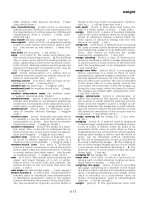Coatings Technology Handbook Episode 3 Part 6 ppt
Bạn đang xem bản rút gọn của tài liệu. Xem và tải ngay bản đầy đủ của tài liệu tại đây (438.05 KB, 17 trang )
106
-2
Coatings Technology Handbook, Third Edition
E
C
=
heat required to expand the vapor from 34
°
C, 100% RH, to 27
°
C, 100% RH
=
9 calories
E
V
=
heat required to expand the air containing the evaporated water in order to reduce its
relative humidity from 100% to the humidity of the ambient air, 50%
=
23 calories
Hence, the total cooling energy derived from evaporating 1 g of liquid perspiration and dissipating it
into the surrounding atmosphere is
E
T
=
578
+
9
+
23
=
620 calories
This is true only, of course, if the clothing is capable of transmitting the vapor to the ambient
atmosphere without a change of phase or of temperature (other than that provided for in the calculation).
It is clear, then, that the moisture vapor permeability of the clothing must be high enough to pass
vaporized perspiration at the rate at which it is being produced at the skin.
106.2 Vapor Permeability Requirements
Any estimate of the vapor permeability requirements of clothing must be based on estimates of a number
of factors that depend on body size and physiology. Since these vary significantly from individual to
individual, and even for one individual from one time to another, no precise values can be given. One
of those factors consists of the metabolic rates corresponding to various levels of physical activity.
Representative values of metabolic rates are shown in Table 106.1. Some of this metabolic energy is used
to perform the work that is being done. Most of it, however, is turned into heat, which must be dissipated.
Some of this is expelled in respiration. The remainder must be dissipated through the evaporative cooling
mechanisms discussed above. Depending on the design of the clothing, some portion of the vaporized
perspiration may reach the surrounding atmosphere directly through vents in the clothing by means of
a bellows-type action. The remainder must pass through the clothing fabric as vapor. Table 106.1 gives
values for the required vapor permeability of the fabric, based on representative values of all these
variables, as well as of the total surface area of the clothing.
It has been suggested that clothing that is to be worn during periods of physical activity have a moisture
vapor permeability of 6000 grams per square meter per 24 hours. Even the densest uncoated sportswear
fabric easily meets this requirement. The addition of an impermeable coating, however, reduces the
permeability to a level often not more than 100 g/m
2
/24h. To ensure that clothing made from coated
fabric is comfortable, this permeability must be raised by as much as two orders of magnitude.
106.2.1 Breathable Films
Three basic approaches have been taken to the manufacture of coatings that are permeable to water vapor
and, at the same time, resistant to the passage of liquid water (so-called breathable films):
TA BLE 106.1
Metabolic Rates, Perspiration Production, and Vapor Permeability Requirements for Various Levels
of Physical Activity
Activity
Metabolic Fate
(W)
Water Evaporation
Rate (g/24 h)
Va por Permeability
Rate (g/m
2
/24 h)
Sleeping 60 600 200
Sitting 100 3800 1300
Gentle walking 200 7600 2500
Active walking 300 11,500 3800
Active walking on the level, carrying a heavy pack 400 15,250 5000
Active walking in the mountains, carrying a heavy pack 600–800 23,000–30,000 8000–10,000
Ve r y heavy work 100
+
3800
+
13,000
+
DK4036_book.fm Page 2 Monday, April 25, 2005 12:18 PM
© 2006 by Taylor & Francis Group, LLC
Coated Fabrics for Apparel Use: The Problem of Comfort
106
-3
1. Puncture the film with needles, laser beams, or other means to produce an array of micrometer-
sized holes.
2. Make the film from a material that can be broken up into fine, fiberlike strands, with micrometer-
sized spaces between the fibers.
3. Create monolithic polymer membranes that contain no through-going pores, in which transmis-
sion of water vapor occurs through a process known as activated diffusion. In such membranes,
the water vapor condenses and dissolves in the surface and then diffuses through to the other side
of the film, where it desorbs and evaporates into the surrounding space.
The first of these approaches, involving the mechanical puncturing of a cast film, appears in some ways
to be a simple and direct way of achieving the desired permeability. However, because the holes need to
be extremely small if water resistance is to be maintained, and very closely spaced if the desired perme-
ability level is to be attained, there is at present no totally successful, economically viable product available.
The production of microporous films by expanding and splitting a continuous film of appropriate
morphology has been a more successful approach. Several such products are commercially available, the
best known being based on a polytetrafluoroethylene film. Others based on polypropylene or polyure-
thane are also being produced.
The third approach, the production of a permeable monolithic film, is being pursued aggressively by
many companies throughout the world. Most of these products are based on a modified polyurethane
or polyester, and several are already in use, particularly in sportswear.
The best of these “breathable” materials have moisture vapor permeabilities as high as about 4000 g/
m
2
/24 h, which is high enough to keep a moderately active individual comfortable. It is not yet high
enough to meet the needs imposed by vigorous activity, or the extreme requirements of, for example,
the long-distance runner, hockey player, or fireman. But it is a significant improvement over the use of
a regular continuous coating.
This is a rapidly changing area that is attracting a great deal of research and development effort.
Recently, a new candidate material based on a modified amino acid [poly(
R
-methyl
L
-glutamate)] has
been announced. This coating was stated to have a moisture vapor permeability of 8000 to 12,000 g/m
2
/
24 h. We can confidently expect a proliferation of products to result and can look forward to a time when
the long-term comfort of water-resistant clothing, even for the most active person, can be ensured.
Bibliography
Fourt, L., and N. R. S. Hollies,
Clothing Comfort and Function.
New York: Dekker, 1970, pp. 21–30.
Greenwood, K., W. H. Rees, and J. Lord, “Problems and protection and comfort in modern apparel
fabrics,” in
Studies in Modern Fabrics.
Manchester, UK: The Textile Institute, 1970, pp. 197–218.
Hollies, N. R. S., and R. F. Goldman,
Clothing Comfort: Interaction of Thermal, Ventilation, Construction
and Assessment Factor.
Ann Arbor, MI: Ann Arbor Science, 1977.
Keighley, J. H., “Breathable fabrics and comfort in clothing,”
J. Coated Fabrics,
15, 89 (1985).
Lomax, G. R., “The design of waterproof, vapour-permeable fabrics,”
J. Coated Fabrics,
15, 40 (1985).
Lomax, G. R., “Coated fabrics. Part I. Lightweight breathable fabrics,”
J. Coated Fabrics,
15,
115 (1985).
Newburgh, L.,
Physiology of Heat Regulation.
Philadelphia: Saunders, 1949, pp. 99–117.
Slater, K., “Comfort properties of textiles,”
Textile Progress
(The Textile Institute, Manchester, UK), 9
(1977).
U.S. Department of Commerce,
Comfort Factors in Protective Clothing
(January 1978–April 1987). NTIS,
PB87-857678, 1987.
DK4036_book.fm Page 3 Monday, April 25, 2005 12:18 PM
© 2006 by Taylor & Francis Group, LLC
107
-1
107
Architectural Fabrics
107.1 Introduction
107-
1
107.2 Products
107-
1
107.1 Introduction
In the late 1960s, the opportunity to economically encapsulate large, clear-spans dictated a light weight
construction approach. The temporary nature of available fabrics was not objectionable, since many of
the structures envisioned, such as halls for international expositions, required relatively short periods of
actual use. This provided an impetus to reconsider the design implications for such structures and finally
to a reconsideration of the materials of construction themselves.*
To fully exploit the potential of the fabric option, there was little doubt that a new generation of
structural fabric would be required: materials tough enough to withstand the rigors of handling by
construction crews, virtually impervious to the ravages of weather, able to meet all applicable life safety
codes including fire hazard, and sufficiently translucent to provide natural illumination in daylight hours.
107.2 Products
While several available fabrics could meet some of these requirements, none would meet them all.
Nevertheless, it seemed reasonable to believe that such properties could be engendered if the proper
selection of materials were made. In retrospect, it now appears that the material eventually selected,
fiberglass and Teflon perfluoropolymer resins, may be unique in their ability to confer these properties
in an efficient and cost-effective manner.
Glass in its fibrous form is an outstanding candidate for a woven reinforcement: it is pound for pound
as strong as steel. It is incombustible, and it is compatible with the elevated temperatures required for
processing in conjunction with the most incombustible resins.
Te flon perfluoropolymer resins are the most chemically inert plastics known and are particularly noted
for their ability to withstand exposure to the ultraviolet radiation, moisture, and smogs associated with
the outdoor environment. The flammability characteristics of these resins are equally outstanding: such
materials will not support combustion in atmospheres containing less than 98% oxygen. Also, because
of their lower heats of combustion, perfluoropolymers contribute substantially less fuel value than a
comparable mass of hydrocarbon polymers. Finally, both the light transmission and flame-resistive
properties can be expected to be maintained indefinitely, since these properties are inherent in the plastic
and are not dependent on additives, which may bloom to the surface and oxidize, or be washed away or
attacked by microorganisms. By working within these functional requirements, a family of permanent
architectural fabrics was developed. Certain characteristics of the composite do present mechanical
*Portions of this chapter were extracted from a presentation made by Dr. John A. Effenberger, Vice President and
Te c hnical Director at Chemical Fabrics Corporation.
Marcel Dery
Chemical Fabrics Corporation
DK4036_book.fm Page 1 Monday, April 25, 2005 12:18 PM
© 2006 by Taylor & Francis Group, LLC
107
-2
Coatings Technology Handbook, Third Edition
problems. The brittleness of fiberglass must be addressed without compromising its inherently high
strength and modulus of elasticity. And its sensitivity to hydrolysis must be effectively counteracted.
Additionally, the low abrasion resistance of perfluoropolymer coatings had to be overcome. Last, a method
for joining fabric panels into roofing elements with structural integrity equivalent to that of the fabric
had to be developed.
The brittleness issue is addressed first by choosing the finest diameter filaments to assure maximum
strand flexibility. The yarns are then plied and woven in a plain configuration with a high degree of
openness to enhance elongation, tear strength, and translucency in a coated fabric. The woven fabric is
subsequently heat set and treated with a finish to inhibit the penetration of moisture into the yarns
during processing, to further enhance tear strength, and to control elongation. The effectiveness of this
process is evidenced by the high initial tensile and tear strength and the retention of tensile strength upon
folding or soaking in water. Typical mechanical specifications for Sheerfill architectural fabrics are shown
in Table 107.1.
Perfluoroethylene, by nature, has a low abrasion resistance. Since architectural fabrics must withstand
the rigors of weather, a method of enhancing this property had to be developed. A glass filler was added
to the outermost coats, which greatly improved the abrasion resistance of the surface without affecting
the self-cleaning properties. A self-cleaning property is inherent in perfluoroethylene coated roofs. This
leads to much lower maintenance cost over conventional roofs. The low coefficient of friction allows dirt,
snow, and water to easily leave the roof.
The procedure for joining panels of fabric into a completed roof is as follows. Panels are lapped to
provide a 3 in. seam area. A film of polyfluoroethylene resin is used as a hot-melt adhesive. Because this
joint must be as structurally sound as the fabric itself, it must be constructed to avoid creep of the adhesive
under design load. These joints are normally as strong as the fabric itself and equally durable.
Aside from the purely mechanical aspects of architectural fabrics, critical considerations include
weatherability, fire safety, acoustics, and solar–optical performance. Weatherability has been assessed both
by accelerated Weather-o-Meter exposure and by continuing real-time exposure at various weather
stations. Accelerated tests data indicate that it is realistic to expect the fabric to retain adequate structural
properties for more than 20 years. The limited data available from real-time exposure tend to corroborate
the expectation of exceptionally long life.
TA BLE 107.1
Typical Specifications for Architectural Fabrics
Property
Sheerfill
FabrosorbIIIIII
We ight, oz/yd
2
44 38 37 14
Thickness, in. 0.036 0.030 0.030 0.014
Te nsile strength, lb/in.
Warp 800 520 620 360
Fill 700 430 480 280
Flexfold strength, lb/in.
Warp 700 440 500 305
Fill 600 360 375 240
Tear strength, lb.
Warp 60 35 50 25
Fill 80 385520
Coating adhesion, lb/in.
Minimum average 15 13 13 4
Minimum single 10 10 11 4
Solar transmission, %
High transmission 11 13 15 23
Low transmission 7 9 9 NA
Solar reflectance, % min 70 67 73 67
Fire resistance of roof coverings (class) A A A
DK4036_book.fm Page 2 Monday, April 25, 2005 12:18 PM
© 2006 by Taylor & Francis Group, LLC
Architectural Fabrics
107
-3
Permanent building codes in the United States have proven in the past to be most unyielding to fabric
structure options. Sheerfill architectural fabric structures, however, have found acceptance under the
most stringent of U.S. codes, and have been approved for every structure submitted, most of which
involve high public occupancy.
Perhaps the most convincing test performed to substantiate the outstanding fire-resistive behavior of
architectural fabrics is the ASTM-E-84 Tunnel Test. In such a test, an asbestos-cement board receives a
flame-spread rating of zero and red oak flooring is rated at 100. Materials rated below 25 are given Class
A certification. The Teflon–fiberglass composites used in permanent structures all are rated Class A in
this demanding test.
Fabrasorb Accoustical Fabric, manufactured by Chemfab, represents a fabric with high noise reduction
capability over a broad frequency range. Fabrasorb is, like Sheerfill, a composite of Teflon and fiberglass.
It, therefore, shares many of its outstanding properties: it is strong, resistant to moisture and mildew,
and highly resistant to fire. However, it has a somewhat porous construction, which facilitates the
attenuation of sound within the fabric. Thus, it has been found to offer highly significant advantages as
a linear material for fabric structures, particularly where it may also serve as a plenum to channel warm
air for snow melting along the inner surface of the outer fabric.
As a result of its more open construction, made possible largely by the reduced mechanical loading
of the liner, the Fabrasorb liner has a relatively high solar transmission. Thus, in addition to its mechanical
and acoustical functions, it is able along with the primary Sheerfill architectural fabric to provide an
essentially double-glazed fabric roof with significant energy-conservant benefits to ordinary double-
glazed windows.
Let us examine the solar–optical properties of architectural fabric in a general sense. The degree to
which light may be transmitted through such fabrics is governed largely by the degree of openness in
the woven fabric. A 400,000 square foot stadium roof has on the order of 20 billion point sources of
light, each approximately 10 to 25 mils on edge. It is not difficult to understand why the transmitted
light is of such a pleasing and diffuse quality.
The absolute level of solar transmission is on the order of 7 to 16%, with the upper limit dictated by
minimal tensile strength requirements and the lower limit dictated by minimal tear strength and coating
adhesion requirements. Since the solar spectrum encompasses wavelengths beyond the visible range, the
actual transmission of visible light is somewhat less than the solar transmission.
Energy savings may be realized with the use of a doubly glazed configuration by the reduced need for
artificial lighting, which can account for up to 50% of the total energy demand in a department store
setting, and a reduced refrigeration requirement that results from very low shading coefficients.
One of the most outstanding characteristics of these fabrics is their ability to reflect upwards of 70%
of the incident solar energy. Such a superwhite external reflector in combination with a liner of Fabrasorb
is capable of providing a doubly glazed roofing system with good light transmission (on the order if 4
to 8%) while providing summertime shading coefficients down to 0.08.
The calculated heat gains for architectural fabric glazings at comparable solar transmissions are sub-
stantially lower than those of reflective glass glazings and suggest a real benefit to be derived from reduced
refrigeration investment and reduced operating costs during the cooling season on a life-cycle cost basis.
Such performance could make a fabric structure more attractive than a conventional structure with
substantially lower initial costs when sited in an appropriate climate.
DK4036_book.fm Page 3 Monday, April 25, 2005 12:18 PM
© 2006 by Taylor & Francis Group, LLC
108
-1
108
Gummed Tape
108.1 Introduction
108-
1
108.2 Products
108-
1
108.3 Manufacturing
108-
2
108.1 Introduction
Paper tape with a coating of an adhesive that may be easily activated by the application of water and
used to seal corrugated cartons, historically has been produced with a coating of animal glue. For the
past 20 to 30 years, adhesive formulas based on thin boiling waxy maize starch have almost completely
replaced animal glue in this product in the United States. In the European market, animal glues have
been replaced by modified potato starch based formulas.
Over the years, in the United States, the demand for plain paper tapes for carton sealing has been
decreasing and these tapes have been replaced by reinforced double-ply tapes. In other areas of the world,
paper tapes command a larger share of the carton sealing market. A product line that is often included
with reinforced carton sealing tape is manufacturers’ joint tape, a product used by manufacturers of
corrugated cartons to form the tube of the carton.
108.2 Products
Paper sealing tapes are described by the basis weight (24 in.
×
36 in. 500) of the paper being coated. They
are identified as light duty, medium duty, and heavy duty. The common base weight is 35 lb per ream
for light duty, 60 lb for medium duty, and 90 lb for heavy duty tapes.
In the reinforced tape market there is little agreement among manufacturers as to what constitutes a
difference in grades. The Gummed Industries Association (GIA)*, a trade association of manufacturers
of gummed tape, has developed voluntary grading standards, but not all manufacturers apply them. The
standards contain a formula method of grading glass reinforced tapes and define the grades as light duty,
medium duty, and heavy duty.
Reinforced paper tapes, after a history of using randomly scattered sisal fibers, cotton yarn in a sine
wave pattern, and rayon in various patterns as the reinforcement, now are nearly always made using glass
fiber yarn. The most popular glass patterns have yarn in the machine direction along with a diamond
pattern in the cross-machine direction. There still is some tape made with a scrim-type pattern of
machine- and cross-directional glass fiber at right angles to each other.
Laminating adhesives are either hot-melt or waterborne adhesives. Hot melts include the traditional
laminating asphalt, which has lost popularity over the years, and amorphous polypropylene. Any rein-
forced tape not using asphalt or a black laminating material is termed “nonasphaltic” by the industry.
Waterborne adhesives may be based on polyvinyl acetate, polyvinyl alcohol, or other paper laminating
*The Gummed Industries Association, Inc., P. O. Box 92, Greenlawn, NY 11740; phone (631) 261-0114.
Milton C. Schmit
Plymouth Printing Company, Inc.
DK4036_book.fm Page 1 Monday, April 25, 2005 12:18 PM
© 2006 by Taylor & Francis Group, LLC
Gummed Tape
108
-3
6 in. apart during this weaving operation. As the chains leave the weaving wand section, the chain channels
angle away from each other, forming a “Y” configuration that moves the chains out to just beyond the
width of the web. While the chain is traveling in the expanding legs of the “Y”, the glass fiber is running
over the chain pins to form an expanded diamond matrix. At this point the channels again return to
travel parallel with the web, carrying the expanded glass fiber matrix into a nip, where it is sandwiched
between the paper piles.
The machine direction glass yarn is fed into this nip at the same time, the strands are held in place
by a comb designed to give the desired spacing. The comb oscillates from 0.25 to 1 in. to ensure proper
winding of the finished product — the yarn causes a protrusion in the lamination and will not allow the
straight winding of a roll if the yarn is not oscillated.
Either of the two paper plies or both may be coated with the laminating adhesive before being brought
together at the nip with the reinforcing fibers. Hot roll coaters or slot die coaters are used. The first
nipping of the laminate sandwich is done in a soft or low pressure nip, followed by a heavily loaded nip.
The paper side of the tape is to the rubber roll side of the nip with the adhesive surface to the steel roll,
thereby lessening the effect of any yarn protrusion on the gummed surface.
The adhesive coating shrinks considerably when it is dried, causing heavy side curl of the coated web.
The glue surface is cracked to relieve some of the curl producing stress in the web. This is done by drawing
the tensioned web over small radius steel bars. This is often done in line on the slitting equipment as the
web is cut to width and length. Good breaking gives about 100 crack lines per inch and is not easily seen
by the naked eye. Before slitting, a secondary machine may be used to pass the tensioned web over bars
set at an angle to the web (30 to 45
°
is common), and then over a 90
°
bar. This gives a three-directional
breaking pattern. To control the breaking and to prevent a pigtail curl from developing, the tension over
each bar may need to be independently controlled and the radius of the bars may need to be different.
Plain paper tapes, reinforced tapes, and manufacturer’s joint tapes are usually supplied in a nominal
3 in. width, with some grades being readily available also in 2.5 in. width. Roll length is highly variable,
ranging from 375 to 800 linear feet for products used in the common bench type of tape wetting devices,
while rolls for automatic taping equipment are run to lengths to give diameters of 20 to 24 in.
Most slitting of tape is done on single-shaft rewinders and with score cut knives. There is some shear
cut slitting done as well. The smaller diameter rolls may be on cores or coreless, with inside diameters
of 1.25 to 1.75 in. Larger diameter rolls are generally on cores with a wall thickness of at least 0.125 in.
and an inside diameter the same as the small rolls or a 3 in. inside diameter core. A bowed roller mounted
between the slitter knives and the windup will cause the individual webs to separate slightly and help to
separate the log of rolls when the shaft is removed.
Roll separation, inspection, and packing are done manually with no automation, except for carton
sealing in some plants. The cartons are identified by a lot number so that any complaints can be traced
through the manufacturing cycle. Finished product is palletized and stretch wrapped or shrink wrapped
for shipping or warehousing.
DK4036_book.fm Page 3 Monday, April 25, 2005 12:18 PM
© 2006 by Taylor & Francis Group, LLC
109
-1
109
Transdermal Drug
Delivery Systems
109.1 Introduction
109-
1
109.2 Attributes of a Transdermal System
109-
2
109.3 Future Approaches to Transdermal Delivery
Systems
109-
4
109.1 Introduction
A “transdermal approach or technology” can be defined as any method that allows a drug or biological
marker to transit skin in either direction. A transdermal drug delivery system allows the drug or molecule
to transit from the outside of skin, through its various layers, and finally into the circulatory system to
exert a pharmacological action. There may be some exceptions to this definition — for example, a system
may concentrate the drug in the skin layers or near the surface of the skin to exert a localized effect, such
as wound dressings for antisepsis or improved healing processes.
The transdermal drug delivery approach offers new opportunities for old drugs and new avenues to
medical therapy. Developing these new products is a complex task. Primarily, today’s transdermal designs
include not only drugs, pharmaceutical vehicles, and other excipients but also polymeric films, specialty
coatings, pressure-sensitive adhesives, and release substrates. They involve many different scientific and
manufacturing disciplines that are unfamiliar to both the pharmaceutical industry and the pressure-
sensitive adhesive industry. New technology that can be brought to bear will expand future opportunities.
In the 1870s, physicians and their associates were not only exploring new materials and adhesives for
binding surgical wounds, but were also including medicaments in these adhesive tapes to treat conditions
that respond to drugs in the systemic circulation. Medicated plasters have been used to treat back pain,
and iodine-impregnated gauze pads were quite popular at one time, but these devices gained disfavor
because of such problems as irritation, side effects, and changes in the drug regulatory environment.
Although, physicians have long been prescribing topical products for treatment of localized skin
diseases, it was not until the 1950s in the United States that a drug was made commercially available for
systemic circulation by means of a topical application. Topical delivery of nitroglycerin was achieved by
means of an ointment that was rubbed into the skin and overwrapped with Saran film, which was secured
to the skin by means of surgical tape. This was the forerunner of the current transdermal device that has
pressure-sensitive adhesives as part of the product. It was not until 30 years later, in the early 1980s, that
a more sophisticated transdermal product appeared on the market.
Several transdermal delivery systems had reached the U.S. market as of 1988. They ranged in design
from the amorphous ointments to solid state laminates. A review of the patent literature indicates a flurry
of activity in developing many different designs. Scopolamine (1980), nitroglycerin (1981), clonidine
(1985), and estradiol (1986) are drugs that have reached the U.S. transdermal market. Drugs that are
Gary W. Cleary
Cygnus Research Corporation
DK4036_book.fm Page 1 Monday, April 25, 2005 12:18 PM
© 2006 by Taylor & Francis Group, LLC
Developing a Transdermal • Selecting Drug Candidate
Transdermal Drug Delivery Systems
109
-3
the skin. Types II, III, and IV have the adhesive and film laminate structure built into the final product.
By understanding these basic designs, their advantages and disadvantages, one can incorporate the most
suitable diffusional mechanism, using the appropriate plasticizers or vehicles, polymers, films or mem-
branes, and adhesives, and matching the diffusivity of the drug through skin to achieve the desired
delivery rate and plasma profile of the drug. The types of material that have been used in transdermal
products that have reached the marketplace include the following:
•Pressure-sensitive adhesives: acrylates, silicone, and rubber-based adhesives
•Release liners: silicone and fluorocarbon coats on paper, polyester, or polycarbonate films
•Backings and membranes: ethylene-vinyl acetate, polypropylene, polyester, polyethylene, polyvinyl
chloride, and aluminum films
•Specialty films: foams, nonwovens, microporous films, vapor-deposited aluminum films
FIGURE 109.1
Schematic diagrams of four types of transdermal drug delivery system designs.
Backing
Backing
Backing
Liquid Drug Reservoir
Modulating or
Nonmodulating Rate Layer
Modulating or
Nonmodulating Rate Layer
Skin Contact Adhesive
Skin Contact Adhesive
I semi-liquid
II liquid lilled laminate structure
III peripheral adhesive laminate structure
IV solid state laminate structure
Drug Reservoir Layer
Drug Reservoir Layer
Protective Foil
Peel Strip
Release Paper
Peripheral
Skin Contact adhesive
DK4036_book.fm Page 3 Monday, April 25, 2005 12:18 PM
© 2006 by Taylor & Francis Group, LLC
Transdermal Drug Delivery Systems
109
-5
an improvement over the parent, or changing the skin permeability by means of chemical or electronic
enhancers. Today, optimizing the formulation of a drug in a transdermal for passive diffusion is the
predominant developmental approach. However, future approaches may include molecular modification
of the drug, or using chemical or electronic means to increase skin permeation.
With the advent of post–World War II technology of electronics, medicine, and chemistry to produce
a diversity of analytical instrumentation and sensitive drug assay methodology, combined with a better
understanding of how the body affects drug metabolism, there have been advances in equipment and
synthetic chemicals to produce new polymers, new film coatings, and new fabricating techniques. These
innovations, as well as recent changes in the regulatory climate, and pressures to produce off-patent drug
entities, are allowing the more venturesome to explore new ways to deliver drugs to the body. In this
developmental climate comes a revitalization of the technique of using the skin as the portal of entry for
drugs by means of transdermal delivery systems.
DK4036_book.fm Page 5 Monday, April 25, 2005 12:18 PM
© 2006 by Taylor & Francis Group, LLC
110
-1
110
Optical Fiber Coatings
Introduction and Background
110-
1
Optical Waveguide Principles
110.2 Coating
110-
2
References
110-
4
110.1 Introduction and Background
The concept of high speed data transmission on a beam of light was demonstrated by Alexander Graham
Bell in 1880. His “photophone” used mirrors and sunlight to transmit low quality voice messages. Today’s
technology has developed to a point of passing extremely high data rates (>2 Gbit/s) unrepeated through
a high purity quartz fiber for distances exceeding 100 km.
Optical fibers offer many advantages over copper conductors and are gaining acceptance for the
following reasons:
1. They carry more signals for greater distances without repeaters. A fiber with a 1 GHz bandwidth
can transmit several thousand simultaneous telephone calls through use of state-of-the-art mul-
tiplexing techniques. Undersea cables have repeaters spaced as widely as 30 to 55 km, whereas
copper cables require signal regeneration every 2 to 5 km.
2. Electromagnetic interference does not occur.
3. Cross-talk is eliminated because the optical signal is maintained in fiber and “short-circuits” do
not occur.
4. Weight and volume of fiber cables are greatly reduced (for the same signal carrying capacity).
These advantages have led to the development of numerous optical fiber telecommunication networks,
with an increasing awareness that the initial growth of this technology for long-distance trunk lines will
continue to accelerate as fiber replaces copper wire in the subscriber loop (residential and business
installations).
110.1.1 Optical Waveguide Principles
In any transparent material, light travels more slowly than in a vacuum. The ratio of these speeds is the
index of refraction (
n
). When light, traveling in a material of one refractive index, strikes a material
having a lower refractive index, the light is bent back toward the higher refractive index material. This
phenomenon can be used to guide a light down a high purity glass rod, if the rod is clad with a material
having a lower refractive index. Current telecommunication fibers employ a doped (germanium, phos-
phorus, etc.) silica core in combination with a lower refractive index (
n
= 1.46) silica cladding. The core
will generally vary in thickness from 8 to 100
µ
m, whereas the outside diameter of the cladding is usually
125
µ
m. When made from pure silica, the resultant fibers have excellent strength (to 14,000 N/mm
2
)
1
,
Kenneth Lawson
DeSoto, Inc.
DK4036_book.fm Page 1 Monday, April 25, 2005 12:18 PM
© 2006 by Taylor & Francis Group, LLC
Handleability • Coating Requirements • Composition of Fiber
110.1
Coatings
111
-1
111
Exterior Wood Finishes
111.1 Introduction
111-
1
111.2 Exterior Substrates
111-
3
111.3 Exterior Finishes
111-
7
111.4 Summary
111-
11
References
111-
11
111.1 Introduction
Wood exposed outdoors undergoes a number of physical and chemical phenomena mostly caused by
moisture influences, sunlight, and temperature. The degradation of wood by any biological or physical
agent modifies some of the organic components of wood. These components are primarily polysaccha-
small quantities, and their concentration determines color, odor, and other nonmechanical properties of
a wood species. A change in the organic components may be caused by an enzyme, a chemical, or
electromagnetic radiation, but invariably the net result is a change in molecular structure through some
chemical reaction.
ering — the combination of chemical, mechanical, and light energies. The weathering of wood is not to
be confused with wood decay (rot), which results from organisms (fungi) acting in the presence of excess
moisture and air for an extended period. Under conditions suitable for decay, wood can deteriorate
rapidly, and the result is far different from that observed for natural outdoor weathering.
Weathering can be detrimental to the surfaces and appearance of wood. Thus, weathering must be
taken into account when considering the preservation and protection of outdoor wood. Being a product
of nature, wood is also subject to biological attack by fungi and insects. Most of these stressing factors,
The primary functions of any wood finish (e.g., paint, varnish, wax, stain, oil) are to protect the wood
surface, help maintain appearance, and provide cleanability. Unfinished wood can be used outdoors
without protection. However, wood surfaces exposed to the weather without any finish are roughened
by photodegradation and surface checking, change color, and slowly erode.
Wood and wood-based products in a variety of species, grain patterns, textures, and colors can be
effectively finished by many different methods. Selection of the finish will depend on the appearance and
degree of protection desired and on the substrates used. Also, different finishes give varying degrees of
protection, so the type, the quality, the quantity, and the application method of the finish must be
considered when selecting and planning the finishing or refinishing of wood and wood-based products.
William C. Feist
Consultant
DK4036_book.fm Page 1 Monday, April 25, 2005 12:18 PM
© 2006 by Taylor & Francis Group, LLC
Wood Properties and Weathering • Wood and Wood-Based
Natural Weathering • Applied Finishes
Products • Water-Soluble Extractives
The relative effects of various energy forms on wood indoors and outdoors are compared in Table
rides (cellulose and hemicelluloses) and polyphenolics (lignin). Extractives are also present in relatively
111.1. The most serious threat to wood indoors comes from thermal energy, and outdoors, from weath-
influencing factors, and weathering effects interact and influence a finished wood surface (Figure 111.1).
111
-4
Coatings Technology Handbook, Third Edition
TA BLE 111.2
Characteristics of Selected Solid Woods for Painting and Finishing
Wood
Density (lb/ft
3
)
at 8% moisture
content
a
Paint-Holding
Characteristic
(I, best; V, worst)
b
Weathering
Resistance to
cupping
(1, most; 4, least)
Conspicuousness
of checking
(1, least; 2, most)
Color of
Heartwood
Oil-Based
Paint
Latex
Paint
Softwoods
Cedars
Alaska 30.4 I I 1 1 Yellow
Incense 24.2 I I — — Brown
Port-Orford 28.9 I I — 1 Cream
Western red 22.4 I I 1 1 Brown
White 20.8 I I — — Light brown
Cypress 31.4 I I 1 1 Light brown
Douglas fir
c
31.0 IV II 2 2 Pale red
Larch 38.2 IV — 2 2 Brown
Pine
Eastern white 24.2 II II 2 2 Cream
Norway 30.4 IV II 2 2 Light brown
Ponderosa 27.5 III II 2 2 Cream
Southern yellow
c
38.2 IV III 2 2 Light brown
Sugar 24.9 II II 2 2 Cream
Western white 27.1 II II 2 2 Cream
Redwood 27.4 I I 1 1 Drak brown
Spruce 26.8 III II 2 2 White
Tamarack 36.3 IV — 2 2 Brown
White fir 25.8 III — 2 2 White
Western hemlock 28.7 III II 2 2 Pale brown
Hardwoods
Alder 28.0 III — — — Pale brown
American elm 35.5 V or III — 4 2 Brown
Ash 41.5 V or III — 4 2 Light brown
Aspen 26.3 III II 2 1 Pale brown
Basswood 25.5 III — 2 2 Cream
Beech 43.2 IV — 4 2 Pale brown
Butternut 26.4 V or III — — — Light brown
Cherry 34.8 IV — — — Brown
Chestnut 29.5 V or III — 3 2 Light brown
Eastern cottonwood 28.0 III II 4 2 White
Gum 35.5 IV III 4 2 Brown
Hickory 50.3 V or IV — 4 2 Light brown
Lauan IV — 2 2 Brown
Magnolia 34.4 III — 2 — Pale brown
Maple, sugar 43.4 IV — 4 2 Light brown
Oak
White 45.6 V or IV — 4 2 Brown
Northern red 42.5 V or IV — 4 2 Brown
Ye llow poplar 29.2 III II 2 1 Pale brown
Ye llow birch 42.4 IV — 4 2 Light brown
Sycamore 34.7 IV — — — Pale brown
Walnut 37.0 V or III — 3 2 Dark brown
a
1 lb/ft
3
=
16.2 kg/m
3
.
b
Woods ranked in group V are hardwoods with large pores, which require wood filler for durable painting. When the
pores are properly filled before painting, group II applies.
c
Lumber and plywood.
DK4036_book.fm Page 4 Monday, April 25, 2005 12:18 PM
© 2006 by Taylor & Francis Group, LLC
Exterior Wood Finishes
111
-9
(film-formers) are also included in the natural finishes. Wood preservatives and fire-retardant coatings
might also be called “finishes” in some respects.
The outdoor finishes described in this section represent the range of finish types that are often used
outdoors. Sources of information on the properties, treatment, and maintenance of exterior wood finishes
are listed in the references at the end of this chapter, as is information on the suitability and expected
life of the most commonly used finishes.
111.3.2.1 Paints
Paints are coatings commonly used on wood and provide the most protection of all the finishes because
they block the damaging ultraviolet (UV) light rays from the sun. They are available in a wide range of
colors and can be either oil- or latex-based. Paints are used for aesthetic purposes, to protect the wood
surface from weathering, and to conceal certain defects.
Paints are applied to the wood surface and do not penetrate it deeply. The wood grain is completely
obscured, and a surface film is formed. Paints perform best on smooth, edge-grained lumber of light-
weight species. This surface film can blister or peel if the wood becomes wet or if inside water vapor
moves through the house wall and into the wood siding because of the absence of a vapor-retarding
material. Latex paints are porous and thus will allow some moisture movement. Some oil-based paints
are resistant to moisture movement, but often they become more brittle with age and do not last as long
as do acrylic latex paints.
Oil-based paint films usually provide the best shield from liquid water and water vapor. However, they
are not necessarily the most durable, because they become brittle over time. No matter how well sealed,
wood still moves with seasonal humidity, thus stressing and eventually cracking the brittle paint. On the
other hand, latex paints, particularly the acrylic paints, remain more flexible with age. Even though latex
paints allow more water vapor to pass through, they hold up better by stretching and shrinking with the
wood. Most recent paint studies indicate that the acrylic and vinyl-acrylic latex paints provide the longest
life of the exterior wood paints.
Of all the finishes, paints provide the most protection for wood against surface erosion and offer the
widest selection of colors. A nonporous paint film retards penetration of moisture and reduces the
problem of discoloration by wood extractives, paint peeling, and checking and warping of the wood. It
is important to note that paint is not a preservative. It will not prevent decay if conditions are favorable
for fungal growth. Original and maintenance costs are often higher for a paint finish than for a water-
repellent preservative or a penetrating stain finish.
111.3.2.2 Solid-Color Stains
Solid-color stains are opaque finishes (also called hiding or heavy bodied). They are available in a wide
range of colors and are made with a much higher concentration of pigment than the semitransparent
penetrating stains. Solid-color stains will totally obscure the natural color and grain of wood. Oil-based
solid-color stains form a film much like p
aint and as a result can peel loose from the substrate. Latex-
based solid-color stains are also available and form a film, as do the oil-based solid-color stains. Both
these stains are similar to thinned paints and can usually be applied over old paint or stains if the old
finish is securely bonded to the wood.
111.
3.2.3 Semitransparent Penetrating Stains
Semitransparent penetrating stains are only moderately pigmented and thus do not totally hide the wood
grain. These stains penetrate the wood surface to a degree, are porous to water vapor, and do not form
a surface film like paints. As a result, they will not blister or peel even if moisture moves through the
wood. Penetrating stains are alkyd- or oil-based, and some may contain a fungicide (preservative or
mildewcide) as well as a water repellent. Moderately pigmented latex-based (waterborne) stains are also
available, but they do not penetrate the wood surface as do the oil-based stains.
The semitransparent stains are most effective on rough lumber, weathered lumber, or rough-sawn
plywood surfaces, but they also provide satisfactory performance on smooth surfaces. They are available
DK4036_book.fm Page 9 Monday, April 25, 2005 12:18 PM
© 2006 by Taylor & Francis Group, LLC
111
-10
Coatings Technology Handbook, Third Edition
in a variety of colors and are especially popular in the brown or red earth tones because they give a
natural or rustic appearance. They are an excellent finish for weathered wood. Semitransparent pene-
trating, oil-based stains are not effective when applied over a solid-color stain or over old paint. They
are not recommended for use on hardboard and oriented strandboard.
An effective stain of the semitransparent penetrating type is the Forest Products Laboratory natural
finish developed in the 1950s. This finish has a linseed oil vehicle, a fungicide to protect the oil and wood
from mildew, and a water repellent that protects the wood from an excessive penetration of water. It is
available in durable red and brown iron oxide pigments that simulate the natural colors of redwood and
cedar. A variety of other colors can also be achieved with this finish.
111.3.2.4 Water-Repellent Preservatives and Water Repellents
A water-repellent preservative may be used as a natural finish. It contains a fungicide or mildewcide (the
preservative), a small amount of wax for water repellency, a resin or drying oil, and a solvent, such as
turpentine or mineral spirits. Water-repellent preservatives do not contain coloring pigments. Therefore,
the resulting finish will vary in color depending upon the species of wood. The mildewcide also prevents
wood from darkening (graying).
The initial application of the water-repellent preservative to smooth wood surfaces is usually short-
lived. During the first few years, the finish may have to be applied every year. After the wood has gradually
weathered to a uniform color, the treatments are more durable and the wood needs refinishing only
when the surface starts to become unevenly colored by fungi.
Inorganic pigments can be added to the water-repellent preservative solutions to provide special color
effects, and the mixture is then similar to the semitransparent pigmented penetrating stains. Colors that
match the natural color of the wood and extractives are usually preferred. As with semitransparent stains,
the addition of pigment to the finish helps stabilize the color and increase the durability of the finish.
Some water-repellent preservatives may also be used as a treatment for bare wood before priming and
painting or in areas where old paint has peeled, exposing bare wood, particularly around butt joints or
in corners. This treatment keeps rain or dew from penetrating into the wood, especially at joints and
end grain, and thus decreases the shrinking and swelling of wood. As a result, less stress is placed on the
paint film, and its service life is extended. This stability is achieved by the small amount of wax present
in water-repellent preservatives. The wax decreases the capillary movement or wicking of water up the
back side of lap or drop siding. The fungicide inhibits surface decay. Water-repellent preservatives are
also used as edge treatments for panel products like plywood.
Water repellents are also available. These are water-repellent preservatives with the fungicide, mildew-
cide, or preservative left out. Water repellents are not effective natural finishes by themselves but can be
used as a stabilizing treatment before priming and painting.
111.3.2.5 Oils and Varnishes
Many oil or oil-based natural wood finish formulations are available for finishing exterior wood. The
most common oils are linseed and tung. However, these oils may serve as a food source for mildew if
applied to wood in the absence of a mildewcide. The oils will also perform better if a water repellent and
a UV stabilizer are included in the formulation. Alkyd resin and related resin commercial formulas are
also available. All these oil systems will protect wood exposed outdoors, but their average lifetime may
be only as long as that described for the water-repellent preservatives.
Clear coatings of conventional spar or marine varnishes, which are film-forming finishes, are not
generally recommended for exterior use on wood. Shellac or lacquers should never be used outdoors
because they are very sensitive to water and are very brittle. Varnish coatings become brittle by exposure
to sunlight and develop severe cracking and peeling, often in less than 2 years. Refinishing will often
involve removing all the old varnish. Areas that are protected from direct sunlight by overhang or are
on the north side of the structure can be finished with exterior-grade varnishes. Even in protected areas,
a minimum of three coats of varnish is recommended, and the wood should be treated with a water-
repellent preservative before finishing. Using compatible pigmented stains and sealers as undercoats will
DK4036_book.fm Page 10 Monday, April 25, 2005 12:18 PM
© 2006 by Taylor & Francis Group, LLC
111
-12
Coatings Technology Handbook, Third Edition
15. R. S. Williams, “Effects of acidic deposition on painted wood,” in
Acidic Deposition: State of Science
and Technology.
Effects of Acidic Deposition on Materials Report 19, National Acid Precipitation
Assessment Program, Vol. 3, Section 4, 1991, pp. 19–165 to 19–202.
16. R. S. Williams, “Effects of acidic deposition on painted wood: A review,”
J. Coat. Technol., 63
(800),
53–73 (1991).
DK4036_book.fm Page 12 Monday, April 25, 2005 12:18 PM
© 2006 by Taylor & Francis Group, LLC









